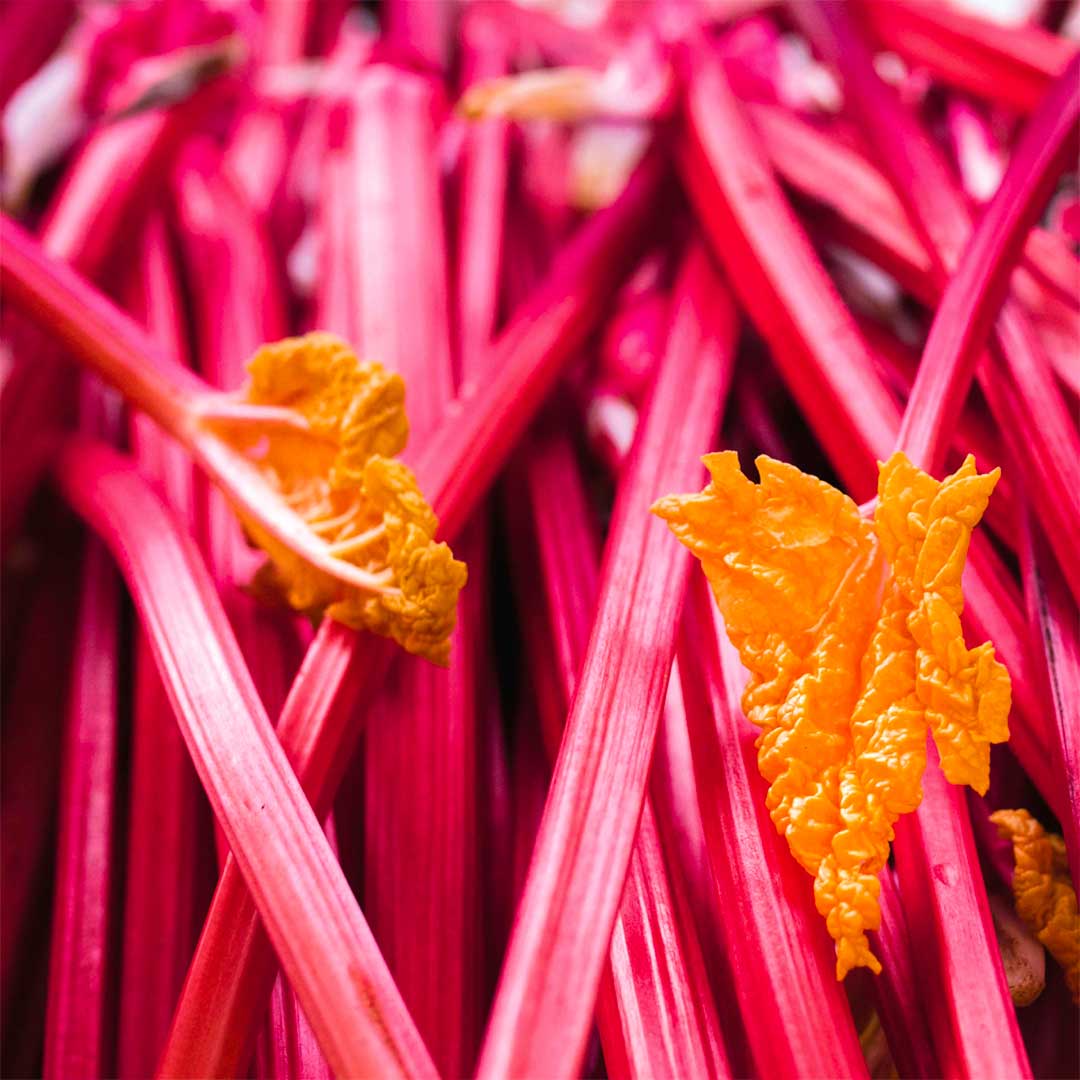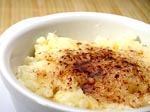Tom Parker-Bowles on forced rhubarb, the crop grown in the dark and harvested by candlelight
Only available for a fleeting moment, rose-hued forced rhubarb — grown in the dark and harvested by candlelight in Yorkshire’s ‘tusky triangle’ — is an ephemeral vegetable with a muted, yet distinct, lip-smacking tartness, says Tom Parker Bowles.


No rhubarb was harmed in the writing of this column. Nor were there any whispers of blackmail, coercion or intimidation of any kind. Those elegant pink stems may be forced, but they’re here, I promise, of their own free will. This is a relief, as forced rhubarb, which disappears in a few weeks’ time, is one of March’s rare seasonal treats. Sure, wild garlic is starting to peep through and English chicory, too, but this is a cusp month that sits, slightly awkwardly, between the last, aged fumble of winter and spring’s lusty thrust.
Still, there’s much to relish in this rhubarb, with its tender limbs and sweet, just sharp allure. Although delicate in appearance, its accent is broad Yorkshire, thicker than black treacle and more bluff than a Boycott ’ow do. Because here, in a nine square mile area of West Yorkshire, between Wakefield, Morley and Rothwell, lies the ‘tusky (or rhubarb) triangle’, the place where it all begins.
The plants start their life outside, grown for a couple of years in rich, fertile soil, which fills those roots with nutrients. A frost is essential, allowing all that stored vim to convert into vigorous growth, once starved of food or light. Which is what happens when the crowns are replanted in dark, long and warm sheds. Back in the old days, these low buildings were heated with coal, locally mined, abundant and cheap. Diesel is now preferred, but the stems still shoot up in the balmy gloom, desperately seeking the sun.
"It’s an ingredient born to be slipped below crumbles and piled into pies (don’t even think about serving these without lashings of custard)"
Harvesting is done by hand and by candlelight, as anything stronger could not only affect the texture and flavour (making it tougher and more bitter), but stop the growing, too. At the very peak of forced rhubarb’s popularity, towards the end of the 19th century, there were hundreds of growers and smallholders, with a dedicated express train, known as the Rhubarb Special, running every night from Christmas to Easter between Ardsley and London. From there, the garish-hued bounty would go on to Spitalfields, Covent Garden and Les Halles in Paris. In the depths of winter, fresh fruit was as rare as a full set of teeth.
Nowadays, there are fewer than a dozen specialist growers, as most of the fields have long been carpeted with Tarmac. Reassuringly, however, the rhubarb has been protected by a European Protected Designation of Origin (PDO) since 2010, which means that only stems grown and harvested in a specific area can be called ‘Yorkshire forced rhubarb’. In our post-Brexit world, it retains its PDO under the UK Geographical Indication scheme.
Funnily enough, the actual forcing process was discovered, in England at least, not in Yorkshire, but the rather more urban environs of the Chelsea Physic Garden. Apparently by accident, in 1817, a plant (and rhubarb is actually a vegetable, the stem of a perennial plant, rather than fruit) was covered by a pot. The resulting stems, starved of light, turned out to be thin, winsome and, although still sharp, far less aggressively so than the outdoor kind.
I do love that sharpness, which is the whole point of rhubarb, forced or not, but a little orange juice and a touch of sugar can smooth its more acidic edges. It’s an ingredient born to be slipped below crumbles and piled into pies (don’t even think about serving these without lashings of custard) that also makes a great sauce for mackerel and pork, cutting through any excess richness. I put it raw into vodka, with a whack of sugar, and keep it in a cool, dark place for a few months. Shake occasionally, sieve and decant. To buy, try E. Oldroyd and Sons (0113–282 2245; www.yorkshirerhubarb.co.uk), an old family firm that has been crucial in keeping this old art alive.
Sign up for the Country Life Newsletter
Exquisite houses, the beauty of Nature, and how to get the most from your life, straight to your inbox.
I found this recipe, by Hugh Fearnley-Whittingstall, years back in The Guardian. There’s something about the combination of crumbly shortbread and soft forced rhubarb that never ceases to delight. ‘Rosewater brings out the slightly floral quality of new season forced rhubarb,’ he writes, ‘but if it isn’t your thing, use orange flower water or a few drops of vanilla extract instead.’
Tom's favourite forced rhubarb recipe: Rhubarb and rosewater compote with shortbread
Ingredients (serves 4)
For the compote
- 500g rhubarb, cut into 2½in pieces
- 50g caster sugar
- ½–2tspn rosewater
For the shortbread
- 100g very soft unsalted butter
- 50g caster sugar, plus a little extra for dusting
- 50g rice flour
- 100g plain flour
- Pinch of salt
Method
Heat the oven to 160˚C/320˚F/gas mark 3. Put the rhubarb in an oven dish with only the water that clings to it after washing and toss with the sugar. Cover with foil and bake for 30–40 minutes, until tender. Leave to cool completely, then gently stir in the rosewater, starting with only half a teaspoon, adding a little more at a time and tasting between each addition, until you have the depth of flavour that suits you.
For the shortbread, beat the butter and sugar until thoroughly blended. Sift in the rice flour, flour and salt and, with a wooden spoon, bring together into a crumbly dough. Use your hands to bring the dough into a ball. Roll out to about ¼in thick, transfer to a tray and chill for an hour.
Line a baking sheet with non-stick parchment or silicone liner. Cut the dough into discs with a cookie cutter, transfer to the baking sheet and bake for 20 minutes, until a very pale, golden brown. Cool on a rack and store in an airtight box or jar.

Strawberry, rhubarb and almond tart with rosemary ice cream
Strawberries and rhubarb make a delicious combination in this pretty tart.

The ultimate 'posh' rhubarb and custard? How to make rhubarb, raspberry and thyme mille-feuille
Here's how to elevate simple rhubarb and custard to something rather smart.

Greatest Recipes Ever: Mark Hix’s rice pudding with rhubarb
Thomasina Miers chooses Mark Hix’s rice pudding with rhubarb as one of her greatest recipes ever
Tom Parker Bowles is food writer, critic and regular contributor to Country Life.
-
 Two quick and easy seasonal asparagus recipes to try this Easter Weekend
Two quick and easy seasonal asparagus recipes to try this Easter WeekendAsparagus has royal roots — it was once a favourite of Madame de Pompadour.
By Melanie Johnson
-
 Sip tea and laugh at your neighbours in this seaside Norfolk home with a watchtower
Sip tea and laugh at your neighbours in this seaside Norfolk home with a watchtowerOn Cliff Hill in Gorleston, one home is taller than all the others. It could be yours.
By James Fisher